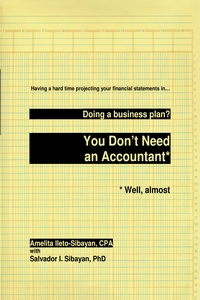- Doing a business plan? You Don't Need an Accountant
- Salvador Sibayan and Amelita Sibayan
- Publisher: Amelita Ileto-Sibayan, CPA
- ISBN: 978-971-94318-0-0
- No. of Pages: 94
- Size: 9"x11"
- Edition: 2009
Description:
Whether you’re an entrepreneur or an entrepreneur wannabe, you must have marketing information at the back of your head. You’re even familiar with the technical and organizational requirements for the business: where to get these, how much, and at what terms. You also know how long it takes to produce a product from start to finish and the cost of making it.
With these out of the way, you can estimate your revenues and match these against your expenses for say a month, a quarter, or a year. This is your income statement, which should tell you if your business is profitable or not. This should not be a problem for you. Then for the same period, you focus on the amounts of cash that the business realizes and pays out. This is your cash flow, which tells you if you have enough cash for your operations from one month to the next. Lastly, you have to project the balance sheet. You try, but then you realize at some point that it doesn’t balance. You try to find out why, and you feel increasingly frustrated because it’s taking so much of your time.
You can avoid this with the help of a new book for entrepreneurs and budding entrepreneurs, especially those who have little or no background in accounting. It’s called Having a hard time projecting your financial statements in doing a business plan? You don’t need an accountant (Well, almost).
First, the book puts the readers at ease in the preface by emphasizing the positive: their knowledge of the market, the technical, and the organizational parts of their business. It assures them that accounting will be a piece of cake as long as they have this given and they are familiar with electronic spreadsheets (which, by the way, is very user friendly). This is followed by a checklist, to make sure that the readers have all the “ingredients” (or the revenue, cost, and expense estimates) for their business.
Next, they are introduced to the accounting equation: Assets = Liabilities + Capital. This is simply (a) the total amount an enterprise owns and uses in the course of doing business equals (b) the amount of obligations to get some of these assets or for unpaid expenses plus (c) the funds provided by the business owner to buy other assets or to cover operating expenses.
The accounting equation is applied in the next chapter, “Working Paper.” This uses a single spreadsheet to provide the data for projecting the income statement, the cash flow statement, and the balance sheet – one that’s not force balanced. What comes next is a chapter on how to transfer the outputs of the “Working Paper” into the usual format of financial statements.
The final “What Happens If…” chapter addresses various concerns relating to the different business ventures (services, trading, or manufacturing) and basic tax matters on sole proprietorships, partnerships, and corporations.
Annexed is a typical chart of accounts, which entrepreneurs can modify with the help of their accountant to suit the needs of their own business.







